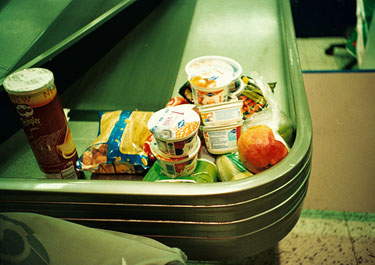Ramona Gardens is not a place many Angelenos would happen upon. Encased by freeways, railroad tracks and the University of Southern California’s hospital, it is difficult to get to. The streets are wide and many of the buildings are empty, with paint chipping off their brick walls. A large apartment complex sprawls across one block, clothesline strung in front of every door. Power lines frame the buildings.
There are no grocery stores, no farmers markets and no community gardens. Ramona Gardens is a food desert, an urban area where people don’t have ready access to healthy foods.
The nearest restaurants are south of the 10 freeway, about a mile away. Many residents don’t have cars and, even if they were to make the trek, they can’t afford restaurant prices.
Ramona Gardens is one of the poorest neighborhoods in Los Angeles. The median family income is less than half that of the national average, and 37 percent of the residents live below the poverty line.
But once a week, restaurants come to town.
In a little grassy area just south of the apartment complex, a bevy of food vendors gather every Saturday morning. They set up collapsible tables and chairs, pitch tents and fire up grills. They sell pupusas, meat, veggies, fruit, funnel cake, sopas and quesadillas. People all over Ramona Gardens come.
“They’re like restaurants without walls,” said Jeanette Castro, who grew up in Ramona Gardens. For many, said Castro, this market is the one time a week where the neighborhood can eat food they didn’t prepare themselves.
Like most of the residents, the food vendors are Mexican immigrants. Teotu Reyes moved from Puebla, Mexico, seven years ago. She started selling food at the markets a couple of months ago to help pay the rent when her family couldn’t find work.
“There aren’t any jobs right now,” Reyes said. None of her family is legal, and work is hard to come by. “We don’t know how to read. We don’t know how to do another job. We’re country people, and that’s what we know how to do.”
So Reyes came to work at the market. She sells traditional Mexican food, just like she did when she lived in Puebla. She still wears the blue-plaid apron she brought with her from Mexico.
Now Reyes has regular customers. Many of the regulars are quenching a little homesickness; they love that they can order their favorite from back home, said Reyes.
“There are restaurants down there,” said Reyes, waving to the south, “but who can afford them?”
At her booth, as with many of the vendors, you can get a full meal for around $2 to $4.
“You can tell they’re all really grateful,” said Reyes. “You can tell they like coming here, ordering food, and sitting down to eat.”
Reyes comes at 5 a.m. with everything to build her booth: two plywood tables, a tent, coolers and cooking things. It takes her over an hour to set it up. By 7 a.m., the market is already swarming with customers.
The vendors aren’t there legally. They used to rent spaces in a parking lot for $5 a piece. They changed the venue to avoid paying the fee, and suddenly all types of businesses moved in – make-up, plants, new and used clothes, toys, shoes and produce. Now the scene resembles a hybrid between a garage sale, Mexican mercado and a Saturday market.
Some bring things from their own homes to sell. Others are business owners with merchandise. Few may have stolen merchandise, such as a card table with dozens of used watches in neat rows.
While Ramona Gardens is not in South Los Angeles, residents must go there to get to restaurants or grocery stores. And once there, they will find significantly fewer options than more affluent communities in Los Angeles.
In South L.A., there is one restaurant for every 1,910 people, verse West L.A. that has one restaurant for every 542, according to the Community Health Council, a think tank in South Los Angeles. What’s more, 1 in 4 South L.A. restaurants are fast food, compared to one in ten in the West.
Not having restaurants is hard on a community. Restaurants create a space for civic society to grow.
Gloria Lopez, a fictitious name to protect her identity as an undocumented person, comes to the market and sells barbecue chicken. But she can’t make it every Saturday. Though she depends on the market for income, sometimes she doesn’t have enough money the following week to buy the chicken.
Those weeks, she said, are devastating. She can barely feed her family.
But in a small way, this market is stimulating the Ramona Garden’s economy. It provides a place for commerce to happen.
“I don’t know what we’d do if we couldn’t come here,” said Lopez.
Related Stories:
The Food Truck of Ramona Gardens
Neighborhood garden brings fresh produce to South L.A.
Experts discuss the ‘politics of food’ in South L.A.









 This week, the United States Department of Agriculture and Department of Health released new dietary guidelines. Updated every five years, the food pyramid taught in classrooms around the nation is a beacon of healthy food choices.
This week, the United States Department of Agriculture and Department of Health released new dietary guidelines. Updated every five years, the food pyramid taught in classrooms around the nation is a beacon of healthy food choices.  Grocery stores between the two communities had a gap just as wide as restaurants.
Grocery stores between the two communities had a gap just as wide as restaurants.




